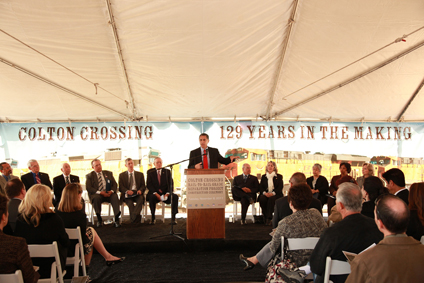Construction on the Rice Avenue / US-101 Interchange will improve access to the Port of Hueneme in Ventura County.
Talking Transportation With Ventura County’s Darren Kettle
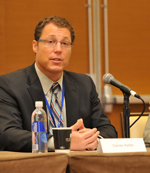
In this month’s interview with a top transportation leader, Ventura County Transportation Commission (VCTC) Executive Director and Mobility 21 Board Member Darren Kettle shares the latest transportation news in Ventura County, his insights on local funding and what’s next for the Los Angeles-San Diego-San Luis Obispo (LOSSAN) Rail Corridor.
M 21: What’s new in Ventura County? What are some of the transportation projects under construction or in the pipeline?
DK: The 101 corridor is “Main Street” Ventura County and that is where our action is for the next several years. Currently under construction are two major local freeway interchange projects, one at Rice Avenue and the 101 in the City of Oxnard and a second, known as Springville, in the City of Camarillo. The Rice Avenue/101 interchange is partially funded from Proposition 1B Trade Corridor funds as Rice Avenue is part of the Port of Hueneme Freight Movement corridor. Construction will be starting soon on the Wendy Avenue/101 interchange in the City of Thousand Oaks. Another major project that will be starting construction in early 2012 is widening of the 101 along the coast between Ventura and Santa Barbara. Currently the 101 narrows to two lanes at the north end of Ventura County and this project will add a lane in each direction for about seven miles. Construction will last about three years and is fully funded from Proposition 1B Corridor Mobility funds.
Lastly, working cooperatively with Caltrans and the City of Thousand Oaks, VCTC used federal stimulus dollars to fund the design for the expansion of the 101/23 freeway-to-freeway interchange in the City of Thousand Oaks. The city is managing the project and has retained CH2M Hill to do the design, while Caltrans is ensuring that the design meets their standards and requirements. The bad news … design will be complete by mid-2012, but due to limited funding, it is not slated for construction until 2015/16 at the earliest.
M 21: Why is it important to have adequate local funding to implement transportation programs?
DK: Well, therein lies part of Ventura County’s greatest transportation system challenge … we do not have a local funding stream. With the exception of the Springville project mentioned above, which is funded primarily from developer fees, all the other projects are funded from federal and state revenues. While over the next couple of years construction will be happening along the 101 corridor, the shelf of new projects is bare.
Nearly two years ago, VCTC launched its first countywide comprehensive transportation planning effort that involved substantial public and stakeholder involvement. The plan looks at the transportation system as a whole and recognizes the importance of freeways and highways, local streets, bus and rail transit, bicyclists and walkers, freight movement and commerce and environmental mitigation. The financial element of the plan identifies an overall funding gap of nearly $3 billion over the next 30 years with the greatest gaps in funding being in the local road program and the major freeway corridor program. Not having a local revenue stream to support local roads and leverage federal and state funds for major freeway projects means our roads will fall into disrepair and congestion will worsen on the US-101 and SR-118 freeway corridors. Not to be left out, while bus and rail transit should continue to receive a steady flow of funding, expansion of Metrolink or express bus service is unlikely without a local transportation revenue source.
M 21: What’s next for the LOSSAN Corridor and how will it impact riders? What are the opportunities and challenges of improving rail service in Southern California?
DK: Ventura County is served by both Metrolink and the Amtrak Pacific Surfliner, which serve the LOSSAN corridor from San Diego to San Luis Obispo. As mentioned above, due to limited revenues, Metrolink service in Ventura County is pretty limited and has seen no expansion in the last decade. Commuters from Ventura County are able to use the Rail2Rail program, which allows riders to board a Surfliner train with a Metrolink ticket, a great convenience for Ventura County rail users. Both Surfliner and Metrolink run on what is known as the Coast Mainline, owned by the Union Pacific Railroad north of the City of Moorpark. The challenge to improving service north of Moorpark is primarily financial as much of the Coast Mainline is single track (and very old track at that) and to expand service it will be necessary to double-track stretches of the Coast Mainline and purchase new rolling stock. The counties of Ventura, Santa Barbara and San Luis Obispo do not have the population of the counties on the southern segment of the LOSSAN corridor, but the needs are no less important. Southern Californians are beginning to look toward alternatives to driving and the Surfliner can serve as a viable alternative to driving a car along the bumper-to-bumper traffic on the 101 Freeway (by the way, the scenery from the observation car is nothing short of amazing).
M 21: How does the Ventura County business community play a role in transportation?
DK: The Ventura County business community is one of our greatest advocates for continued investment in the transportation system as it is that system that moves commerce, tourism, employees, and with construction, creates jobs. Over the last several years, VCTC’s business partner in the Mobility 21 coalition has been our local chambers of commerce led first by retired Camarillo Chamber President Tom Kelly, and now Oxnard Chamber President Nancy Lindholm. At the countywide level, the Ventura County Economic Development Association led by Bill Buratto and the Economic Development Collaborative of Ventura County and their Executive Director Bruce Stenslie have been true transportation champions.
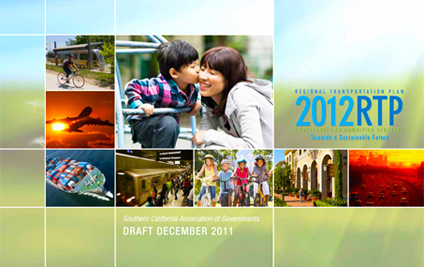
SCAG Nears Completion on Regional Transportation Plan
As the Metropolitan Planning Organization for six counties in our region, the Southern California Association of Governments (SCAG) is responsible for developing a long-range transportation plan. The Regional Transportation Plan (RTP) provides a vision for transportation investments and uses growth forecasts and economic trends to identify regional transportation strategies. In early December, SCAG will release the draft RTP, setting the 20-year outlook for transportation projects in Imperial, Los Angeles, Orange, Riverside, San Bernardino and Ventura counties.
With the enactment of Senate Bill 375 to reduce greenhouse gas emissions from cars and light duty trucks, SCAG is developing a Sustainable Communities Strategy to integrate transportation and environmental planning. Under the RTP, $450 million in road, transit, pedestrian and biking projects have been identified — yet there is a budget shortfall of at least $125 million over the course of the plan. The strategy also identifies alternative funding mechanisms, including an increase in the state and federal gas taxes, a vehicle miles traveled tax, freight fees, tolling and congestion pricing.
You’ll have the opportunity to comment on the draft RTP when it is released in December before its final adoption in April 2012.
San Diego Adopts Transportation Plan With 40-Year Outlook
Excerpt from SANDAG’s rEgion E-newsletter
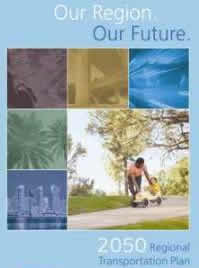
After two years of careful work and extensive public input, the San Diego Association of Governments (SANDAG) Board of Directors adopted the 2050 Regional Transportation Plan and Sustainable Communities Strategy (SCS), a balanced vision for the evolution of the San Diego region’s transportation system over the next 40 years.
While SANDAG has been updating regional transportation plans for many years, the 2050 RTP is unique in that it covers an unprecedented 40 years and includes a new SCS, now required by state law. The San Diego region was the first in the state to comply with this new law, drawing a great deal of attention locally, statewide and nationally. The 2050 RTP lays out a plan for investing an estimated $214 billion in local, state and federal transportation funds. The largest proportion of the funds will go toward transit, which will receive 36 percent of the funds in the first 10 years, with 34 percent going to highway improvements (largely for the addition of high occupancy vehicle lanes to existing freeway corridors to support transit services, carpools and vanpools) and 21 percent to local roads and streets. The percentage dedicated to transit will grow each decade, up to 44 percent from 2021 to 2030, 47 percent in the third decade and 57 percent the last decade of the plan. The RTP stimulates $4.4 billion annually in projected regional economic output, creates 35,600 jobs per year in the San Diego region and calls for equitable distribution of investments throughout the region.
Remembering Larry Zarian

Mobility 21 sends our condolences to the family of former Glendale City Councilmember Larry Zarian, who passed away in October, and remembers the many contributions he made to transportation. Zarian — a businessman, public servant, community leader, radio talk show host and a local cable TV talk show producer — was deeply committed to improving transportation on both local and national levels. The 73-year-old also served as a board member for the Los Angeles County Metropolitan Transportation Authority and as a California Transportation Commissioner. Zarian was instrumental in the expansion of the Glendale Beeline from a two-bus shuttle on Brand Boulevard to a multi-line system that now includes the communities of La Crescenta and Montrose. He also spearheaded a campaign to revive the Glendale train station as a full-fledged transportation center, including interface between rail and bus services. Zarian was a recipient of the 2010 Mobility 21 Lifetime Achievement Award.
Chris Lytle announced as Port of Long Beach Executive Director

Last month, the Long Beach Board of Harbor Commissioners voted to name Chris Lytle as the Port of Long Beach’s new Executive Director.
“Chris’ extensive public and private experience make him the ideal leader for our Port,” said Harbor Commission President Susan E. Wise. “On the private side, he’s operated shipping terminals around the world, and fully understands the unique issues facing public ports in California. He has a great rapport with our customers, and while he understands the industry, he’s also very open to new ideas and innovations.”
Lytle, a Mobility 21 Advisory Board Member, will succeed Dick Steinke’s 14-year leadership as Executive Director.
Port of Long Beach Hosts Greenhouse Gas Grant Workshops
Nonprofit organizations and government agencies are encouraged to apply for the Port of Long Beach’s $5 million grant program to fund local projects aimed at cutting greenhouse gas emissions. Eligible projects include renewable power, energy efficiency, clean transportation, tree-planting and others.
Applicants may seek funding for more than one project, for a total grant request of up to $1 million. Join the Port of Long Beach at an upcoming workshop to learn more about the grant opportunity:
Thursday, Dec. 8, 4 p.m., Long Beach Neighborhood Resource Center
425 Atlantic Ave., Long Beach, 90802
Wednesday, Dec. 14, 7 p.m., Long Beach City Council Chambers
333 W. Ocean Blvd., Long Beach, 90802 (Motorists enter parking structure on south side of Broadway between Chestnut and Cedar avenues)
Grant applications and guidelines for the Greenhouse Gas Emissions Reduction Grant Program and more information are available atwww.polb.com/greenhousegrants. Or contact the Port at grants@polb.com or 1-888-789-GRANT (1-888-789-4726).
Federal Highway Administrator Victor Mendez shares the history of Colton Crossing at a groundbreaking ceremony. Once complete, the grade separation of Colton Crossing will help improve safety, air quality and the efficient movement of goods to other parts of the country.
Construction Begins on Historic Colton Crossing
Federal Highway Administrator Victor Mendez joined state and local officials to help break ground on the $208 million Colton Crossing Rail-to-Rail Grade Separation Project. The construction of an overpass bridge in the City of Colton at this historic crossing will allow trains traveling on the Union Pacific Railroad to pass over the Burlington Northern Santa Fe tracks. The two lines have intersected each other for more than a century, causing delays for more than 135 freight trains daily.
“SANBAG was involved throughout the environmental and design alternative process on this historic project,” stated SANBAG Interim Executive Director and Mobility 21 Board Member Ty Schuiling. “We and our partners on the project worked closely with the community to develop and select an alternative that addresses their concerns. The construction phase has now begun under the leadership of the Union Pacific Railroad.”
During the press conference, Mendez touted the job creation power of infrastructure projects. “It is helping put people in Southern California back to work, stimulating the local economy and boosting the region’s competitiveness by ending a major shipping bottleneck.”
Notable speakers at the groundbreaking ceremony included U.S. Congressman Joe Baca, California Department of Transportation Acting Director Malcolm Dougherty, California State Senators Bob Dutton and Gloria Negrete-McLeod, California State Assemblymember Wilmer Amina Carter, County of San Bernardino Supervisor Josie Gonzales, California Transportation Commissioner Joe Tavaglione, SANBAG President Larry McCallon, Colton Mayor Sarah Zamora and Riverside County Transportation Commissioner Bob Botts.
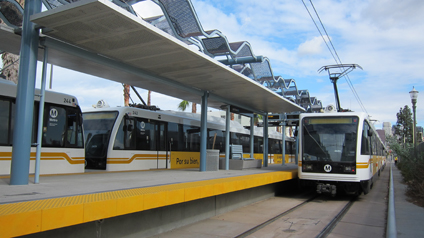
Metro Begins Testing Light-Rail on Exposition Line
Train testing continues for Phase I of Los Angeles Metro’s 8.6-mile Exposition Line, as finishing touches are applied. When completed, the $932 million light-rail line will have 12 stations serving USC, Exposition Park, the Mid-City communities, the Crenshaw District and Culver City.
Pre-revenue service — when trains run on a simulated schedule but without passengers — will begin soon. Metro will select an opening date for the public once all systems and trains are thoroughly tested.
The Metro website metro.net (go to Transit Safety) is reminding pedestrians and motorists to pay attention to signs around the tracks and at intersections, in particular the “keep clear” and “wait here” signs painted on streets and sidewalks. The public also is being cautioned to watch for flashing “train” signals, listen for bells and obey all traffic signals and lowered crossing gates.
Phase II of Expo, from Culver City to Santa Monica, is funded by the Measure R half-cent sales tax, approved by voters in 2008. Phase II broke ground this fall.
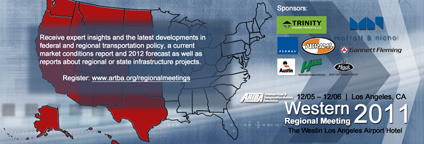
American Road & Transportation Builders Association (ARTBA) Western Region Meeting
December 5 – 6
The Westin Los Angeles Airport Hotel
www.artba.org/regionalmeetings
At ARTBA’s upcoming Western Regional Meeting, the association’s top staff and industry experts from the public and private sectors will provide conference attendees with key federal and regional transportation policy updates, a current market conditions report and 2012 forecast, along with reports about regional or state infrastructure projects. The meeting will also include plenty of time for networking and business development discussions.

California Transportation Foundation Forum
Tuesday, Jan. 24, 2012
Sheraton Grand in Downtown Sacramento
www.transportationfoundation.org
California’s transportation policy makers will bring attendees up to speed on what to expect in the new year. Learn what the Legislature, Administration, Congress and interest groups have in store, including high-speed rail, federal funding, state budget shortfall impacts to transportation and more.
TRANSPORTATION EVENTS IN THE COMMUNITY
Dec. 5-6
American Road & Transportation Builders Association: Western Region Meeting
more info | register
Tuesday, Dec. 6
WTS Orange County:
Annual Awards Gala
more info | register
Tuesday, Dec. 6
Community Outreach for Public Infrastructure Projects Seminar
more info | register
Wednesday, Dec. 7
BDA/OC:
Holiday Social
more info | register
Thursday, Dec. 8
Association of California Cities Orange County: Holiday Reception
more info | register
Monday, Dec. 12
WTS San Diego:
Annual Holiday Luncheon
register
Thursday, Jan. 19
WTS Inland Empire:
Annual Awards Dinner
more info
Tuesday, Jan. 24
California Transportation Foundation: Transportation Forum
more info | register



